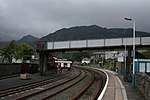Glynllifon Street railway station
Blaenau FfestiniogDisused railway stations in GwyneddPages with no open date in Infobox stationRailway stations in Great Britain closed in 1883Railway stations in Great Britain opened in 1883 ... and 1 more
Use British English from May 2017
Glynllifon Street railway station was a temporary northern terminus station of the Festiniog and Blaenau Railway (F&BR), sited between the street of the same name and Cwmbowydd Road in Blaenau Ffestiniog. It was never named.
Excerpt from the Wikipedia article Glynllifon Street railway station (License: CC BY-SA 3.0, Authors).Glynllifon Street railway station
Glynllifon Street,
Geographical coordinates (GPS) Address Nearby Places Show on map
Geographical coordinates (GPS)
| Latitude | Longitude |
|---|---|
| N 52.9934 ° | E -3.9338 ° |
Address
Glynllifon Street
Glynllifon Street
LL41 3DU , Ffestiniog
Wales, United Kingdom
Open on Google Maps










